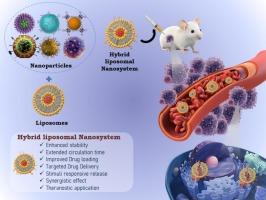Liposome-based hybrid nanoplatforms: advancing cancer therapy through enhanced drug delivery and synergistic strategies
IF 6.3
2区 化学
Q1 POLYMER SCIENCE
引用次数: 0
Abstract
Liposomes, as biocompatible and biodegradable vesicles, have long been utilized for drug delivery due to their ability to encapsulate both hydrophilic and hydrophobic pharmaceuticals, enhance drug stability, and reduce systemic toxicity. However, conventional liposomes face challenges such as limited selectivity and rapid clearance by the reticuloendothelial system. To overcome these limitations, hybrid liposomal nanosystems have emerged as a promising strategy, integrating advanced functional components such as photosensitizers, hyperthermia agents, polymers, and targeting ligands. These hybrid platforms enhance site-specific drug delivery, enable controlled release, and facilitate the co-delivery of multiple therapeutic agents, thereby improving bioavailability and minimizing off-target effects. Additionally, they leverage the enhanced permeability and retention effect for tumor accumulation and utilize receptor-specific interactions within the tumor microenvironment. This review explores recent advancements in liposome-based hybrid nanosystems, highlighting their efficacy in overcoming tumor heterogeneity and drug resistance. Furthermore, preclinical studies on various cancers, including melanoma, liver, lung, and breast cancer, are discussed to underscore their therapeutic potential. The transformative capabilities of these hybrid nanoplatforms pave the way for personalized, precise, and more effective cancer treatments, offering new avenues for integration into conventional oncology.

基于脂质体的混合纳米平台:通过增强药物传递和协同策略推进癌症治疗
脂质体作为生物相容性和可生物降解的囊泡,由于其能够包封亲疏水药物,提高药物稳定性和降低全身毒性,长期以来一直被用于药物递送。然而,传统的脂质体面临着选择性有限和被网状内皮系统快速清除的挑战。为了克服这些限制,混合脂质体纳米系统已经成为一种很有前途的策略,它集成了先进的功能成分,如光敏剂、热疗剂、聚合物和靶向配体。这些混合平台增强了位点特异性药物递送,实现了控制释放,并促进了多种治疗药物的共同递送,从而提高了生物利用度并最大限度地减少了脱靶效应。此外,它们利用增强的渗透性和保留效应来积累肿瘤,并利用肿瘤微环境中受体特异性的相互作用。本文综述了基于脂质体的杂化纳米系统的最新进展,重点介绍了它们在克服肿瘤异质性和耐药方面的功效。此外,对各种癌症的临床前研究,包括黑色素瘤,肝癌,肺癌和乳腺癌,讨论强调其治疗潜力。这些混合纳米平台的变革能力为个性化、精确和更有效的癌症治疗铺平了道路,为整合到传统肿瘤学中提供了新的途径。
本文章由计算机程序翻译,如有差异,请以英文原文为准。
求助全文
约1分钟内获得全文
求助全文
来源期刊

European Polymer Journal
化学-高分子科学
CiteScore
9.90
自引率
10.00%
发文量
691
审稿时长
23 days
期刊介绍:
European Polymer Journal is dedicated to publishing work on fundamental and applied polymer chemistry and macromolecular materials. The journal covers all aspects of polymer synthesis, including polymerization mechanisms and chemical functional transformations, with a focus on novel polymers and the relationships between molecular structure and polymer properties. In addition, we welcome submissions on bio-based or renewable polymers, stimuli-responsive systems and polymer bio-hybrids. European Polymer Journal also publishes research on the biomedical application of polymers, including drug delivery and regenerative medicine. The main scope is covered but not limited to the following core research areas:
Polymer synthesis and functionalization
• Novel synthetic routes for polymerization, functional modification, controlled/living polymerization and precision polymers.
Stimuli-responsive polymers
• Including shape memory and self-healing polymers.
Supramolecular polymers and self-assembly
• Molecular recognition and higher order polymer structures.
Renewable and sustainable polymers
• Bio-based, biodegradable and anti-microbial polymers and polymeric bio-nanocomposites.
Polymers at interfaces and surfaces
• Chemistry and engineering of surfaces with biological relevance, including patterning, antifouling polymers and polymers for membrane applications.
Biomedical applications and nanomedicine
• Polymers for regenerative medicine, drug delivery molecular release and gene therapy
The scope of European Polymer Journal no longer includes Polymer Physics.
 求助内容:
求助内容: 应助结果提醒方式:
应助结果提醒方式:


